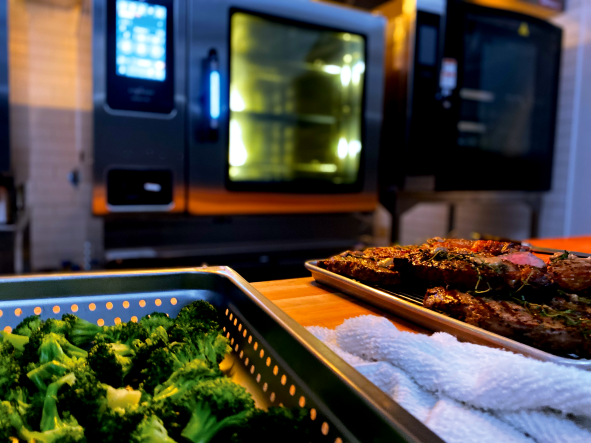Alto-Shaam
Lower Cost Service Models for Corporate Food Programs
Are you trying to find a lower cost service model for a food program? Companies have several choices when it comes to corporate food prorams. Learn more!


Over the past few years, providing food for employees has gone from a nice benefit to virtually a requirement for companies that want to stay competitive when it comes to staffing. Not only does a food program lead to happier workers by eliminating the need to rush out to a busy fast-food restaurant for lunch, it improves production by keeping employees on-site during meal periods. Instead of having to hurry through their meal and get back to the facility, a food program allows workers to enjoy a relaxing break and ensures they’re back at work when their break is over.
What are corporate food programs?
Although many companies place vending machines in the breakroom or corporate cafeteria, a corporate food program is much more than that. Instead, the company itself provides meals or snacks, similar to the way schools serve lunch to students. It can be funded in a variety of ways. The company can fund the program completely, employees can pay for meals, or it can be a combination of both.
Corporate food programs offer a variety of benefits along with a boost in morale. They can improve worker health by providing food of higher quality than what comes from a vending machine or a fast-food drive-thru. That, in turn, can lead to lower health care and workers’ compensation costs, a reduction in absenteeism and improved employee engagement.
Additionally, a corporate food program can help facilitate employee interaction by having everyone break bread together, resulting in a stronger team.
The three food program options
Companies have several choices when it comes to implementing a corporate food program.
The easiest (but most expensive) option would be to have meals delivered to the site as needed. Companies can arrange a partnership with a third-party delivery service and one or more local restaurants. One advantage of that option is that it allows companies to include remote workers by having meals delivered to their homes. On the other hand, such arrangements can be difficult to keep on schedule, and a late delivery could disrupt the entire operation.
Another option would be to delegate the task of operating the program to a third-party vendor. There are many corporate food service providers, and handing off management of the program can relieve a company of the administrative tasks that come with managing the purchasing and service of food.
The third option is to run the program internally. Although that may be the least expensive option, it will require additional staff, intensive training on food storage, handling, and preparation, and the purchase of equipment needed to prepare those meals.
The considerations for a successful corporate food program
No matter how a company implements a corporate food program, there are a host of factors that will need to be taken into account. That’s where a company such as Alto-Shaam can help. Alto-Shaam has been providing cooking and holding equipment for corporate foodservice programs of all types and sizes for more than 65 years.
Considerations for a successful corporate food program include:
Low cost
Of course, cost will be one of the primary factors of any corporate food program. If food is to be prepared on-site, the company will likely need to invest in cooking equipment. That will require access to electricity and possibly water, so equipment that minimizes the use of both and can perform a variety of cooking functions is preferable. Alto-Shaam’s Prodigi™ combi ovens, for example, do the work of a convection oven, kettle, steamer, fryer, smoker, and more. Their innovative boilerless design provides unmatched performance and efficiency and enhances control over recovery, cooking times, and food quality using 80% less water. For added flexibility, Prodigi combi ovens are equipped with ChefLinc™ remote oven management system, connecting operators to ovens, anytime, anywhere. Execute automatic software downloads, push and pull recipes, view detailed reports and more from a single location.
Quality Food
Maintaining food quality is a prime consideration as well. Quality will likely be a concern even if a company chooses to have meals delivered. Alto-Shaam’s heated holding equipment incorporates Halo Heat® technology to keep food warm and flavorful, maximizing quality and minimizing waste.
Equipment that incorporates Alto-Shaam’s Halo Heat surrounds food with gentle, radiant heat without the use of extremely hot elements, added humidity, or fans. Halo Heat allows for food preparation outside of busy service times, flexibility, and less waste.
Space Saving
One of the main challenges of implementing a corporate food program is the space it entails. It’s a safe bet that most corporate facilities weren’t designed with food preparation in mind, so bulky cooking equipment that needs dedicated ventilation will be out of the question.
Fortunately, many of Alto-Shaam’s ovens are designed with those considerations in mind. H Series Vector® multi-cook ovens, for example, are ideal where space is at a premium. They feature a compact footprint and ventless operation, eliminating the need for an exhaust hood.
Alto-Shaam makes corporate food programs simple
Alto-Shaam offers a full package of equipment solutions that can make implementing any corporate food program a breeze. In addition, Alto-Shaam can offer culinary support to enhance that program. With a food program built on Alto-Shaam equipment, your employees will be excited to come to work.
Take a look at the foodservice products Alto-Shaam has to offer and contact one of our experts for more information.
